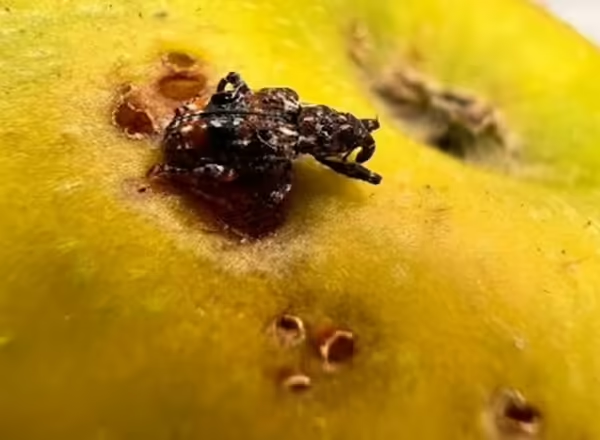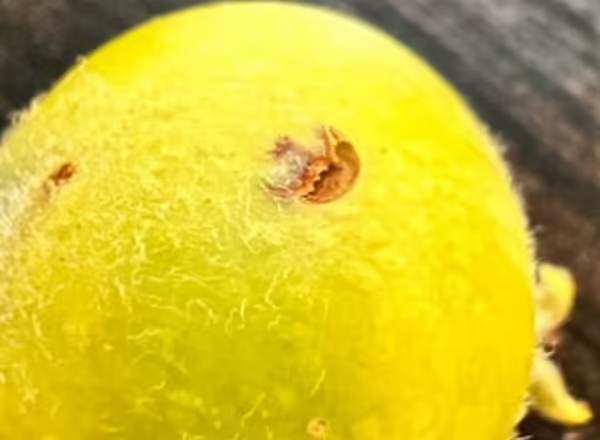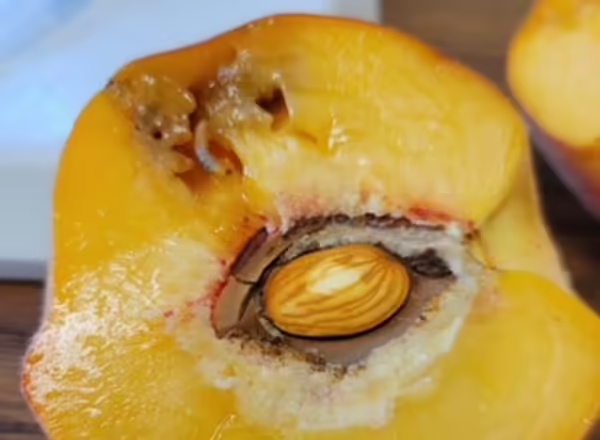
Plum curculio is a native pest distributed throughout the peach-growing areas of the United States. It feeds on almost all stone and pome fruits, including apples, peaches, and plums.
The plum curculio damages the fruit by feeding and laying eggs within the fruits. The egg hatches inside the fruit, allowing the larvae to feed and develop internally, inducing the fruit drop and crop loss. If the pests are not controlled in time, it can cause a huge loss in fruit production.
How to Identify Plum Curculio
The plum curculio is a small snout weevil that is brownish-black in appearance and measures 5 to 6 mm in length. Adults have grayish-white patches and humps on their backs. Eggs are laid inside the fruit and are minute, whitish, and elliptical-shaped. Larvae develop inside the fruit and have a little whitish body, brown heads, and no legs, measuring around 6 to 7 mm when fully grown.
Life Cycle and Biology
The plum curculio has one or two generations in a year, depending on the strain. The northern strain is univoltine or has one generation in a year. In contrast, the southern strain is bivoltine or has two generations per year. The overwintering adult moves to the orchard in early spring and begins feeding and ovipositing or laying eggs inside the young fruit.
Adult activity is seen in the orchard as early as late March or early April. Eggs are laid singly inside the fruit, and on average, an adult female lays 400 to 500 eggs in its lifetime. The egg hatches inside the fruit in about a week, and larvae tunnel inside the fruit. Larvae undergo four instars or molting periods, and the last instar comes out of the fruit to pupate in the soil. The multivoltine plum curculio emerges from the pupation site and continues another generation in the orchard, while the univoltine plum curculio emerges and overwinters beneath the soil or leaf litter in or near the orchard. The plum curculio in Illinois have two generations.
Damage
Both the adult and larvae of plum curculio are responsible for crop injury. The egg-laying injury by adults can be identified as a crescent-shaped scar on the skin of the developing fruit, and feeding scars are observed as small round holes on the fruit’s surface. Inside the fruit, the larval makes a tunnel-shaped structure and feeds upon the flesh. Plum curculio infestation in the young fruit causes the fruit to drop. The infested fruit is unfit for human consumption and marketing.



Monitoring and Management
Plum curculios can be monitored using beating sheets and trunk traps baited with benzaldehyde lures. It can be controlled by a calendar-based insecticide spray application program after detecting first signs of damage. Pyrethroids and neonicotinoids are common insecticides used to suppress the adult population in the orchard. The removal of fallen fruits from the orchard is a cultural method of controlling it.
Authors
Kacie J. Athey and Karuna Kafle. 2023. “Life Cycle and Biology of Plum Curculio.” University of Illinois Extension.
Sources
- Akotsen-Mensah, C., Boozer, R., & Fadamiro, H. Y. (2010). Field evaluation of traps and lures for monitoring plum curculio (Coleoptera: Curculionidae) in Alabama peaches. Journal of Economic Entomology, 103(3), 744-753.
- Brett R. Blaauw and Tzu-Chin Liu (2021). Plum Curculio: An Incessant Pest of Peaches. UGA Cooperative Extension Circular 1224. Retrieved from extension.uga.edu/publications/detail.html?number=C1224&title=plum-curculio-an-incessant-pes.
- Lampasona, T. P., Rodriguez-Saona, C., Leskey, T. C., & Nielsen, A. L. (2020). A review of the biology, ecology, and management of plum curculio (Coleoptera: Curculionidae). Journal of Integrated Pest Management, 11(1), 22.
- Leskey, T. C., Wright, S. E., Saguez, J., & Vincent, C. (2013). Impact of insecticide and fungicide residue contact on plum curculio, Conotrachelus nenuphar (Herbst), mobility and mortality: implications for pest management. Pest Management Science, 69(4), 464-470.
Photos: Kacie J. Athey and Karuna Kafle, University of Illinois Urbana-Champaign.
